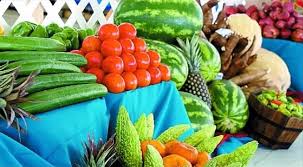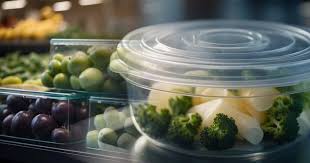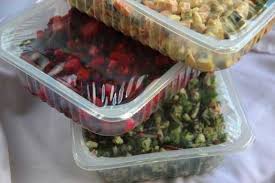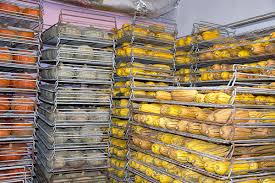Consumers increasingly demand a year-round supply of high-quality fruit and vegetables, and this demand has been met in part by the use of refrigerated storage.
However, the development of controlled atmosphere (CA) and modified atmosphere (MA) storage offers further opportunities for extending the storage life of seasonal perishable produce, when refrigeration alone is not sufficient.
Read Also: 15 Medicinal Health Benefits Of Aspidosperma quebracho-blanco (Quebracho Blanco)
Understanding Controlled Atmosphere and Modified Atmosphere Storage

While there is no formal definition of CA storage, it can be assumed to be the control of the levels of certain gases around, and therefore within, fresh fruits and vegetables.
Controlled atmosphere storage supplements cold storage and is only successful when applied at low temperatures. Standard refrigeration units are therefore integral components of controlled atmosphere stores.
The extended storage life of produce is achieved by reducing the respiration rate, browning reactions, sprouting, softening and decay of fruit and vegetables.
Modified atmosphere (MA) storage (or modified atmosphere packaging (MAP)), on the other hand, is a condition where the fruit or vegetable is enclosed within a sealed plastic film, which is slowly permeable to the respiratory gases.
The gases will change within the package, thus producing lower concentrations of oxygen and higher concentrations of carbon dioxide than exist in the fresh air. The modified atmosphere may also be defined as ‘an atmosphere of the required composition created by respiration, or mixed and flushed into the product enclosure’.
Although the precise details of how CA and MA work are not fully understood and are the subject of continuing research, it is accepted that the effects that varying the levels of oxygen and carbon dioxide in the atmosphere have on crops will vary with factors such as the crop species and cultivar; the growing conditions before harvest; the degree of ripeness of the climacteric fruit; the concentration of the gases in the store or package; the crop temperature; and the presence of ethylene in the store.
There are also interactive effects of the two gases, so that the effect of the carbon dioxide and oxygen in extending the storage life of a crop may be increased when they are combined.
Moreover, as well as maintaining the postharvest quality and extending the shelf-life of produce, CA and MA are also beneficial in reducing or eliminating insect and pathogen damage during transit and storage – this is particularly important as consumers demand fewer chemicals in food crops.
Benefits and Limitations of Controlled Atmosphere and Modified Atmosphere Technologies in Agriculture
While the technical benefits of CA and MA storage have been demonstrated for a wide range of fruit and vegetables, the economic implications of using this comparatively expensive technology have often limited commercial application.
However, with technological developments, more precise control equipment and the reducing cost, the technology is finding a wider commercial use for an increasing range of crops. There are different types of CA storage depending mainly on the method or degree of control of the gases.
The two most commonly used systems are: Static CA storage: where the product generates the atmosphere; and Flushed CA storage: where the atmosphere is supplied from a flowing gas stream that purges the store continuously.
While CA technology has largely focused on the long-term storage of bulk fruit and vegetables, more recently both CA and MA have been applied to the short-term storage of certain commodities.
These include some high-value crops where limited production in locations distant from consumption areas justify the use of CA and MA to extend storability, and some lightly processed fruits and vegetables (e.g. chopped and shredded lettuce, sliced and shredded carrots and sliced celery, cucumbers, radishes and green peppers).
In most cases, perishable commodities are stored under constant conditions, especially at low temperatures. However, even under these conditions, the commodity is experiencing physiological and metabolic changes.
For this reason, researchers are looking at the storage process as a dynamic system and the use of flexible control rather than constant-value systems to obtain a qualitative improvement.
Studies have looked at neural networks and genetic algorithms for realizing the optimal control of fruit storage. Optimum storage conditions for fruit and vegetables depend upon several factors, including the cultivar, stage of maturity at harvest and growing conditions.
Read Also: 10 Medicinal Health Benefits Of Astrocaryum aculeatissimum (Tucum)
Use of High Nitrogen Atmospheres for Storage of Agricultural Produce

The storage of some fruits in total nitrogen or nitrogen-rich atmospheres can be beneficial. Ripening of plums stored in total nitrogen has been reported to be almost completely inhibited (Anon. 1920).
Plums were able to tolerate, for a considerable period, an almost complete absence of oxygen without being killed or developing an alcoholic or unpleasant flavour.
For strawberries, 100% and 99% nitrogen atmospheres reduce mould growth during 10 days of storage at 1.1°C with little or no effect on flavour (Parsons et al. 1964).
Similarly, for peaches, decay was reduced during storage in either 100% or 99% nitrogen at 60°F; off-flavours were detected in fruit after 4 days in 100% nitrogen, but none in those stored in 99% nitrogen.
Controlled Atmosphere Transport of Fresh Agricultural Produce
Large quantities of fresh fruit and vegetables are transported by sea-freight refrigerated (reefer) containers. It was estimated that the world fleet increased four-fold from 1993 to 1997 when there were around 38,000 reefer containers.
Relatively small but increasing numbers of containers (approximately 1,000 containers) are being used for the CA transportation of fresh fruit and vegetables.
These commodities include apples, apricots, asparagus, avocados, bananas, broccoli, cantaloupes, cauliflowers, cherries, eggplants, kiwifruit, limes, mangoes, peaches, nectarines, pears, pineapples, plums, sweetcorn and tomatoes.
Several technical problems hindering the use of CA transportation in the past (the lack of gas-tight containers, suitable systems for gas control and analysis, and adequate CA-generating systems) have now largely been overcome.
A common problem was the maintenance of gas-tight conditions. The leakage from some early systems was as much as 5 m³ h⁻¹, but leakage from current systems can be below 1 m³ h⁻¹ (Garrett 1992). Much of this leakage is through the door (Thompson 1998) and can be reduced by the use of plastic curtains inside the door.
However, these curtains are difficult to fit and maintain under working conditions. A system introduced in 1993 had a single door instead of the double doors of reefer containers and was easier to make gas-tight.
There are several commercial systems available and these can be broadly classified as either CA or MA systems.
The latter requires the injection of an appropriate mixture of gases into the sealed container at the beginning of the journey with no subsequent control, so the atmosphere will constantly change during transport.
Controlled atmosphere containers have a mechanism for measuring the changes in gases and adjusting them to a pre-set level. Standard reefer containers can be converted to CA containers either permanently or temporarily. The systems used to generate the atmosphere in the containers fall into three categories:
Category i: The gases can be carried in a compressed liquid form in steel cylinders at the front of the container, with access from the outside. This system involves injecting nitrogen into the container to reduce the level of oxygen.
Oxygen levels are maintained by the injection of nitrogen if the leakage into the container is greater than the utilization of oxygen through respiration by the stored crop. If the respiration of the crop is high, the oxygen can be replenished by ventilation.
Category ii: Membrane technology may be used to generate the gases by separation. The carbon dioxide is generated by the respiration of the crop and nitrogen is injected to reduce the oxygen level.
Nitrogen is produced by passing the air through fine porous tubes, made from polysulphones or polyamides, at a pressure of about 5–6 bar. These will divert most of the oxygen through the tube walls, leaving mainly nitrogen which is injected into the container.
Category iii: The gases can be generated in the container and recycled with pressure absorption technology and swing absorption technology. This system uses ventilation to control oxygen levels and a molecular sieve to control carbon dioxide.
Application of Modified Atmosphere Packaging in Agricultural Produce Handling

Modified atmosphere packaging (MAP) involves the sealing of commodities in plastic films so that the composition of gases of respiration and transpiration in and around the product is altered.
For fresh fruits and vegetables, this is commonly achieved by wrapping individual items, boxes of produce or a pallet of boxes in a plastic film. The films can be slowly permeable to carbon dioxide, oxygen and other gases, even water vapour, depending on their thickness and composition.
Modified atmosphere packaging has been known for several decades to have great potential in extending the post-harvest life of several fruits and vegetables.
Modified atmosphere packaging is also advantageous in maintaining some minimally processed tropical fruits such as durian, jackfruit, mangosteen, papaya and pineapple.
However, overall, reported results for MAP are very variable and thought to be due to a lack of experimental control. Some of the reported beneficial effects of MA may be due to maintaining a humid atmosphere around the commodity, and not to gas modification.
Modified atmosphere packaging works by slowing down the deterioration of the ‘fresh-cut’ or minimally processed fruit and vegetables.
Types of Gases Used in Modified Atmosphere Packaging of Agricultural Produce
The three main gases used commercially in MAP are oxygen, carbon dioxide and nitrogen (nitrogen is used as a filler gas to prevent pack collapse, which may occur in atmospheres containing high carbon dioxide).
Recently, there has been some interest in the potential applications for the use of novel gas mixtures (e.g. argon and nitrous oxide), although these are largely at the experimental stage.
The gases and their concentrations should be tailored for each product (specific variety). The modified atmosphere may be produced naturally by respiration (passive MA) and by the application of gas flushing techniques (equilibrium MA).
Do you have any questions, suggestions, or contributions? If so, please feel free to use the comment box below to share your thoughts. We also encourage you to kindly share this information with others who might benefit from it. Since we can’t reach everyone at once, we truly appreciate your help in spreading the word. Thank you so much for your support and for sharing!

